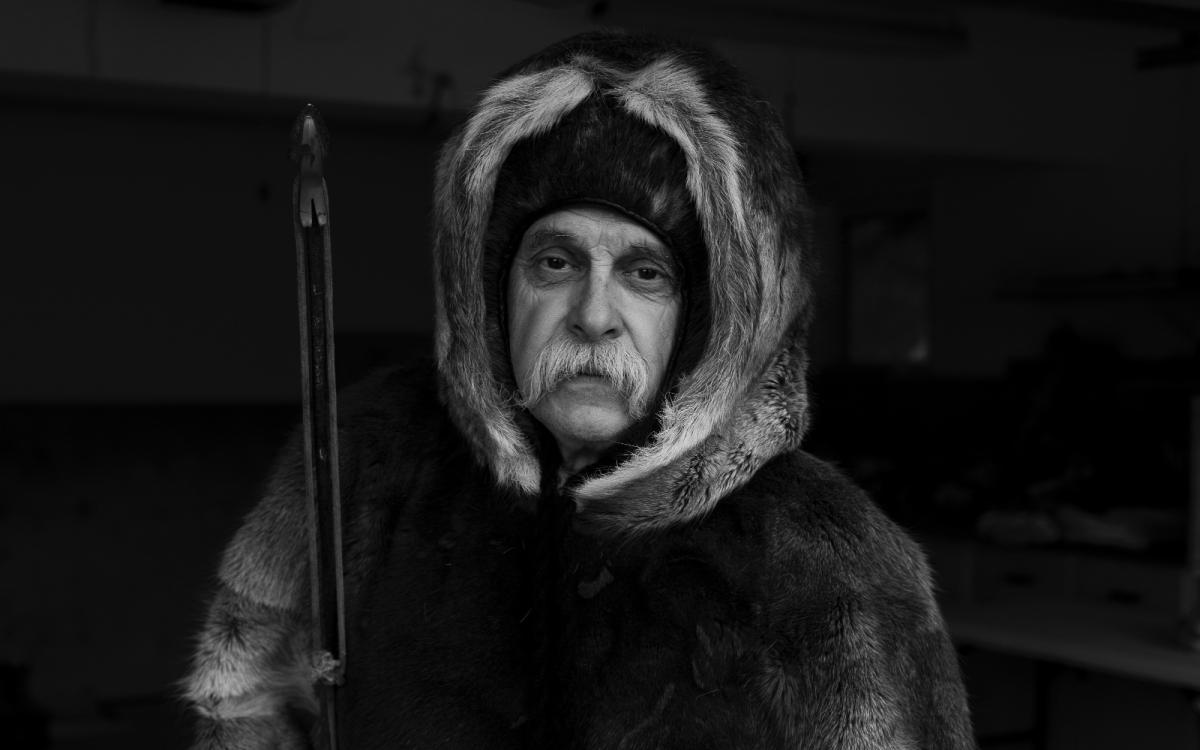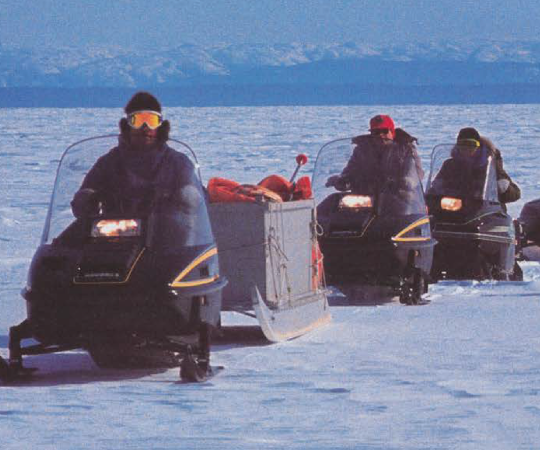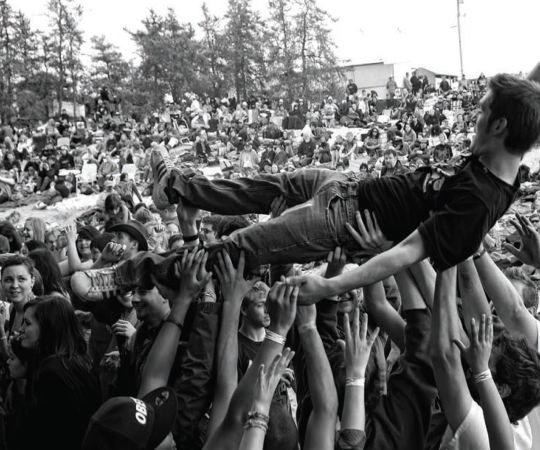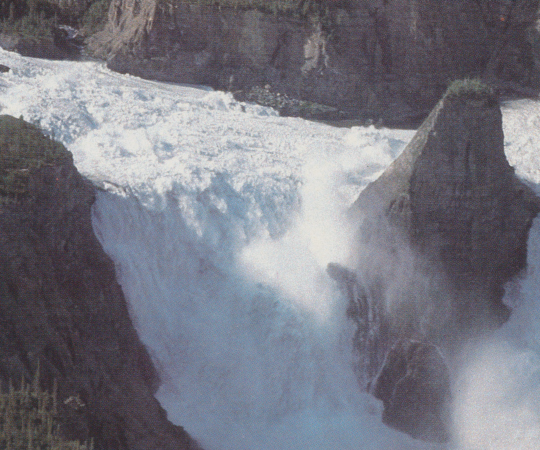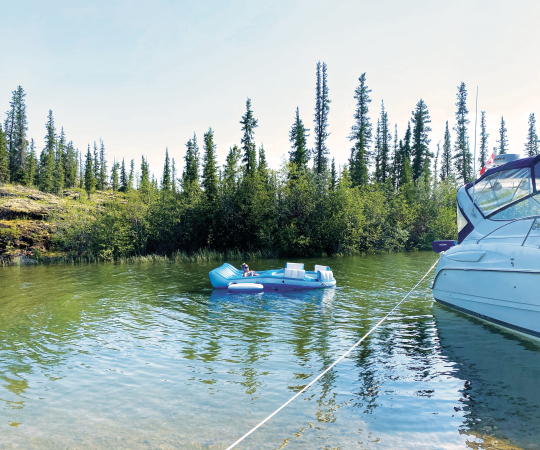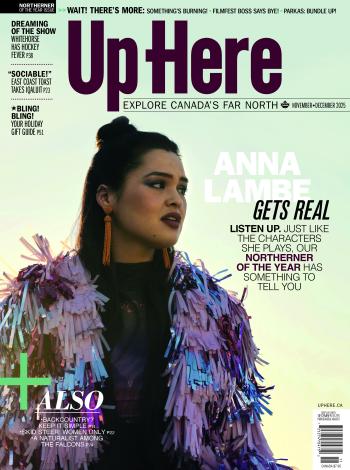Ron Allen rummages through his deep freeze, pulling out rumpled plastic bags bulging with caribou hide and seal-skin clothing, many almost half a century old. He carefully sorts the custom-made Inuit parkas, western Arctic mittens and mukluks into neat piles.
“You have to keep them frozen, otherwise they just dry out and disintegrate,” says Allen. His deepfreeze treasure chests share his home’s spic-and-span garage with a Harley Davidson motor bike and rows of neat tool racks.
Scattered throughout his Yellowknife home is a fascinating array of handmade, life-on-the-land tools; prized souvenirs; and cherished memories from a challenging career as one of the first resident wildlife officers based in the central Arctic.
“I learned a lot,” says Allen, reflecting on the essential lifestyle he adopted. “Coming from living where there were trees, anything you needed you could make it out of something. Being on the Barrens was a totally different skillset.”
Now in his mid-seventies, Allen, a lean, compact man who chats with an easy drawl and a quick chuckle. He still sports the same handlebar moustache he brandished decades ago that earned him his Inuit name, Aiviq.
“When you’re out in the cold, you’ve got icicles building and your moustache starts looking like the tusks of a walrus,” he says. “Instead of trying to remember my name, they just called me ‘the guy who looks like a walrus.’”
. Allen comes alive with stories from his decades in the North. Most of the items he’s collected now sit unused, but they — and his adventures — remain carefully preserved. Though frozen, they still bring back plenty of warm memories.
Allen uncoils a beautifully crafted sealskin dog whip, about 10 metres long and still supple and raw-smelling. He refuses to demonstrate its power, pleading a lack of practice and knowing that, like a firearm, this whip is capable of serious damage. Properly used, it’s only intended to warn or guide an errant sled dog.
“If it ain’t listening to you to go either left or right, you only snap the whip in the air,” he says. The sharp loud crack in the cold sets the path forward.
Allen grew up in Bible Hill, Nova Scotia, a village about an hour from Halifax. He roamed the Salmon River and Bay of Fundy as a child, the second-youngest of five to a mom who was a teacher and a dad who ran an auto-body shop.
“I knew a lot about tools, fixing things and putting them back together,” he says. That skillset would be his career gateway into the rapidly changing North.
In 1969, in the midst of a science degree at Ontario’s Trent University, Allen signed up for a biology field camp.
“The professor realized, ‘Hey! This guy got that old generator going!’” recalls Allen. “He recommended me to a Lands and Forests team as someone who might be handy out in a field camp. So I lucked out on my very first summer job, working in the bush in the Ottawa Valley.”
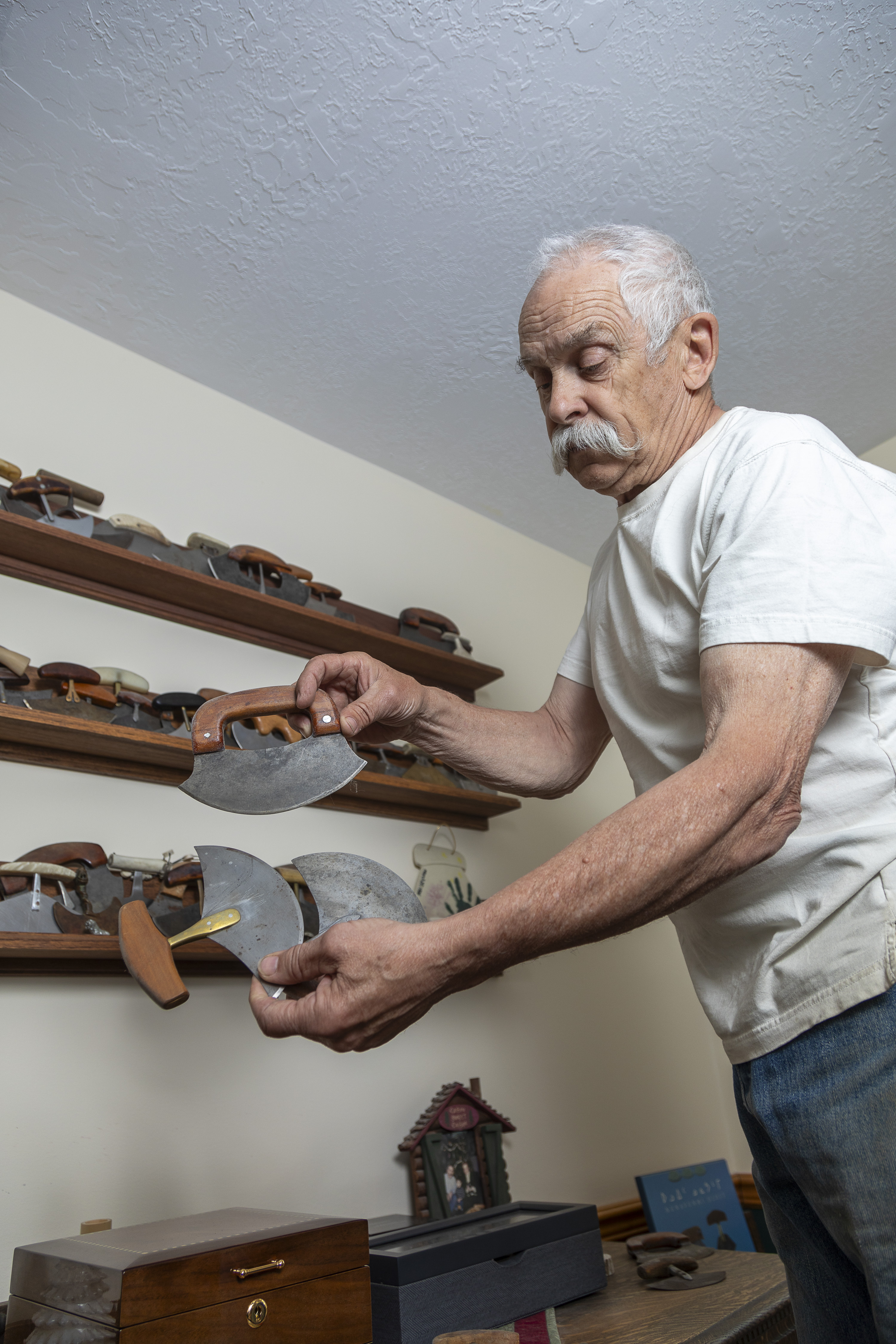
Eight years later, Allen was lured north by the government of the NWT, though not before the interviewer warned him about the rigours he’d have to deal with as a wildlife officer in the eastern Arctic:
— “You know, it’s kinda isolated up there…”
— “Oh, really?”
— “…And you might have to do some polar bear denning surveys.”
—“Oh, really?
So I was quite thrilled to land that job.”
Allen, wife Lesley and their three-year-old son, Jeremy, made their way to Hall Beach, now Sanirajaq, where he became the first resident enforcement officer in the region. Right away, he knew things were going to be different.
“The local people told me right off the bat that polar bears will hunt you,” he says. “So if you’re out on the floe edge looking for seals, memorize as best you can the landscape. Every few minutes, look around again. If something has changed, something has moved. You’re smaller than a walrus, barely bigger than a seal. You’re lunch.”
Displaying his cache of cold-weather clothing, mostly caribou, Allen praises the importance of layers. Four pairs of socks worn at a time, slippers and boots for the feet, then either caribou or polar-bear pants, a hooded caribou parka over a soft caribou jersey, worn with the hair-side next to the skin, and a cap made of the soft hide of a square flipper seal.
Seals have lots of uses out on the land, especially when it’s 35 below and you’re dancing to stay warm, says Allen. “The first thing you do is open the seal, have a piece of liver and a piece of fat. It’s way better than coffee all day long.”
His first task at his new job was to catch and sample 1,300 kilograms of Arctic char from nearby Hall Lake to see if a commercial harvest could be sustained. He hired families from Hall Beach and nearby Iglulik to net the char, motoring down in his Peterhead boat every other day to pick up the harvest, sample, clean and pack the fish in the community freezer.
Allen’s work showed that while a commercial harvest was viable, the economics weren’t. Ultimately, most of the catch went to buyers at the Fox Main DEW line station.
In Hall Beach, he learned how to work without an office when headquarters was 800 kilometres east in what’s now Iqaluit, and he learned to communicate without a phone, occasional single-side band radio and maybe once-a-week air service.
“It could take six weeks to get a form filled out,” he says with a shrug.
By October of his first year, with the arrival of two new snowmachines on that summer’s sealift, Allen was out on the land. “I was here, there and everywhere, looking at what was going on with the marine mammal hunting, caribou hunting, wastage.”
Out in the bush or on the featureless Barrens, ravens are the best scouts. “If you see a raven and it’s going that way, you go that way too,” says Allen, “and oh, look, there’s some caribou!”
He was also backed up by Moses, a local hire in the wilderness office who helped teach Allen about life in the North, including local cuisine.
“I was quite happy to eat anything,” he says — a huge digestive advantage for a newcomer starting a country food diet very different from what he was raised on.
And for emergency rations? Pilot biscuits, that hard, bland bush staple, fit perfectly in a coffee can.
“That’s a trip down memory lane. You can still buy them at the Co-Op [in Yellowknife].”
In the garage, Allen unrolls a sleeve of well-used harvesting and skinning tools, some that he made himself. One is a meter-long oak shaft with three notches and a stout curved hook for hauling heavy seals into a boat; the notches latch over the gunwale, holding the carcass while the hunter gets a fresh grip.
“When you hunt seals and belugas, they’re pretty slippery. How do you manage to hold it and cut it into pieces?” he says. “So I got to appreciate the local way of making a hook to hold the greasy hides and harpoons to catch them.”
His snow knife is a coarse-toothed, store-bought saw customized with his own handle. To loosen the strands of a rope and splice one end into a strong loop, he uses a fid— a tapered 20-centimetre tool the thickness of a fat marker pen at one end. Allen’s fid is pure Arctic, made out of a solid ivory narwhal tooth, perfectly shaped and polished for the task.
Ingenuity is the name of the game in the Arctic;if you can fix it, you fix it with whatever you can, claims Allen. He recalls a days-long, 290-kilometre winter journey between Repulse Bay and Hall Beach when his partner’s snowmachine failed after a spark plug misfire burned a small hole in a piston head.
“We’re in the middle of nowhere, doing nothing, the weather’s crapped out. He takes the cylinder head off of the engine and files the hole a bit bigger. Then he takes a spent .30-30 brass cartridge, taps it into the hole, and beats the cartridge flat to plug the hole. He puts it back together…. It’s running much better!”
The crafty fix took up a whole day, but it got the pair home.
On another solo trip, Allen snapped a ski on his machine. He went back to his komatik, the long wooden freight sled dragged behind the snowmachine, and pried off one of the cross boards.
“I get out my rifle and shoot four holes in the ski.” Now he has a way to bolt the board to the busted ski. Slowly, carefully, Allen made it home seven hours later.
His craftiness, traced back to his dad’s repair shop and the example set by his Inuit companions, saved him from a lonely night in the cold — or worse.
One brilliant story of merging machine and mammal Allen remembers comes from Frobisher Bay. The drive shaft of a Peterhead boat — the sturdy, 15-meter vessel regarded by many as the best Arctic harvesting boat ever built — was leaking oil from a worn-out gasket.
“The owner happened to have a walrus,” says Allen “He fashioned a new gasket out of the thick hide and boiled down enough walrus fat to top up the lost oil for the drive shaft.”
The list goes on. Hall Beach hunters who found a ready source of metal for making harpoon heads from the aluminum propellers of a nearby airplane crash; hooks that were fashioned from old snowmachine skis.
Allen’s own engine kit is a carefully curated assortment of socket drivers, a crescent wrench, pliers, screwdrivers, a hand drill and a chain grip, some dating back to his father’s auto shop.
His craftiness is also evident in his on-the-land survival kit.
“I’ve gotta have something to ignite a fire,” he says. “I’ve gotta have a knife, a chunk of snare wire, a heavy caliber .30-06 rifle and a pump action shotgun, electrical tape, a tough moleskin bandage, a string of sinew for sewing a ripped parka. You’re gonna be surprised what you can make with that kinda stuff.”
In the garage, he turns to a pair of black, hairless well-worn ringed seal boots. “You’ve probably never seen this before — rubber boots before there were rubber boots.” The secret is incredibly tight stitching making the seams virtually waterproof.
Mittens of the same style were for cold water harvesting, though shorter than the long gauntlets that go over parka sleeves to deflect the wind when snowmobiling and mushing. The shorter mittens tuck into long sleeves and keep snow and water from leaking down into the hands of a working harvester.
Allen’s sleeping bag is also caribou, and he extolls its virtues over down-filled models. “If you’re out at minus 40, and the moisture comes off of you, it gets in the feathers and you can’t get it out and that’s building up every day. But if you have caribou, you take it outside, beat it, and the frost comes out.” Leaving only a dry bag with extra insulation from the hollow caribou hair.
Bold patterns of inlaid seal on the parkas in his freezers are more than decorative. The fringing on a caribou parka baffles strong winds that otherwise tend to blow inside the clothing. And why do eastern Arctic pull-over parkas have pointed hoods? “That’s so when you fall through the ice, there’s something for your pals to grab on to and pull you out.”
But fashion changes, and so do the times. Bulky white military-style double-lined boots are Allen’s cold-weather footwear choice nowadays. And to cut the sun’s glare, he prefers modern tinted sunglasses over a set of bone eye goggles.
In all, the Allen family was stationed in seven posts, starting with the GNWT at Hall Beach and Iglulik in 1977 and, five years later, Tuktoyaktuk. He joined the federal Department of Fisheries and Oceans in Rankin Inlet, then Frobisher Bay (now Iqaluit), Inuvik and finally Yellowknife before retiring in 2008.
His wife Lesley taught in four communities before the family arrived in Yellowknife in 1994, when she crossed over to administration with Arctic College and the GNWT Department of Education.
Sadly, in the midst of a busy and rewarding life, personal tragedy struck in 1991 when Allen’s 17-year-old son Jeremy died in an accident while at school in British Columbia. The couple grieved the loss for years until, at age 50, they adopted three-year old Dylan in Yellowknife, where their grown-up son now lives and works. “A remarkably bright kid,” says Allen. “When he was four, he’d ask questions like, ‘How far are the stars?’”
Over the decades Allen was one of the few non-Inuit to witness the loss of a lifestyle truly dependent on nature. Inevitably, skills and traditions slowly gave way to the waves of change that ‘outside’ influence and technology brought.
“Things changed as people became less dependent on having to go out and do things for themselves.” But Allen doesn’t lament all those changes. “It’s not easy living off the land.”
Always up for a thrill, Allen took up the decidedly scary sports of luge and skeleton racing to the international competition level early in the 2000s before a serious knee injury sidelined him. Nowadays, h’s a member of the Gwich’in Renewable Resources Board and is a long-serving board member of the Avens Seniors Society in Yellowknife. He has taught firearms certification and guides for
hunting and nature lodges. A red canoe and a snowmachine are parked in his backyard, ready at a moment’s notice.
. Does he see a future home for his remarkable collection?
“I have no idea,” Allen says. “Wouldn’t know where to begin.”
But for now those treasures remain frozen, waiting for the right idea to come along.

